BCO6653 - Management of Information Technology: Big Data Analysis
VerifiedAdded on 2023/06/08
|6
|2362
|66
Annotated Bibliography
AI Summary
This assignment consists of an annotated bibliography focusing on current practices in big data analytics. It includes summaries and analyses of four research articles from Elsevier and the British Educational Research Association. The articles cover topics such as big data analytics for disaster response using sentiment analysis, the societal impact of big data in Europe, big data concepts and methods, and the opportunities and challenges of big data analytics in higher education. Each annotation includes an abstract, methods and data used, results and conclusion, strengths and weaknesses, and reasons for use, providing a comprehensive overview of the current state and potential applications of big data analytics.
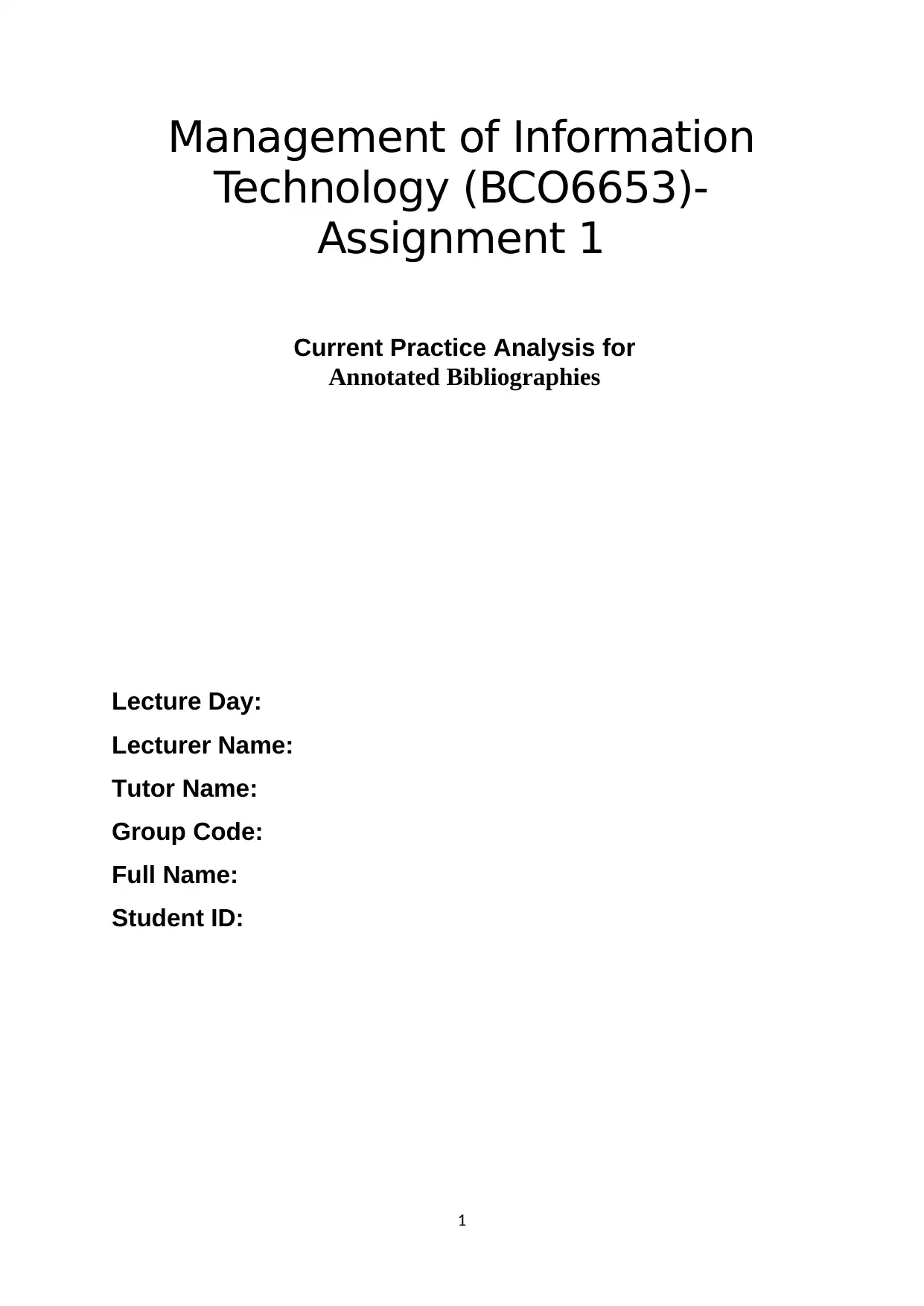
Management of Information
Technology (BCO6653)-
Assignment 1
Current Practice Analysis for
Annotated Bibliographies
Lecture Day:
Lecturer Name:
Tutor Name:
Group Code:
Full Name:
Student ID:
1
Technology (BCO6653)-
Assignment 1
Current Practice Analysis for
Annotated Bibliographies
Lecture Day:
Lecturer Name:
Tutor Name:
Group Code:
Full Name:
Student ID:
1
Paraphrase This Document
Need a fresh take? Get an instant paraphrase of this document with our AI Paraphraser
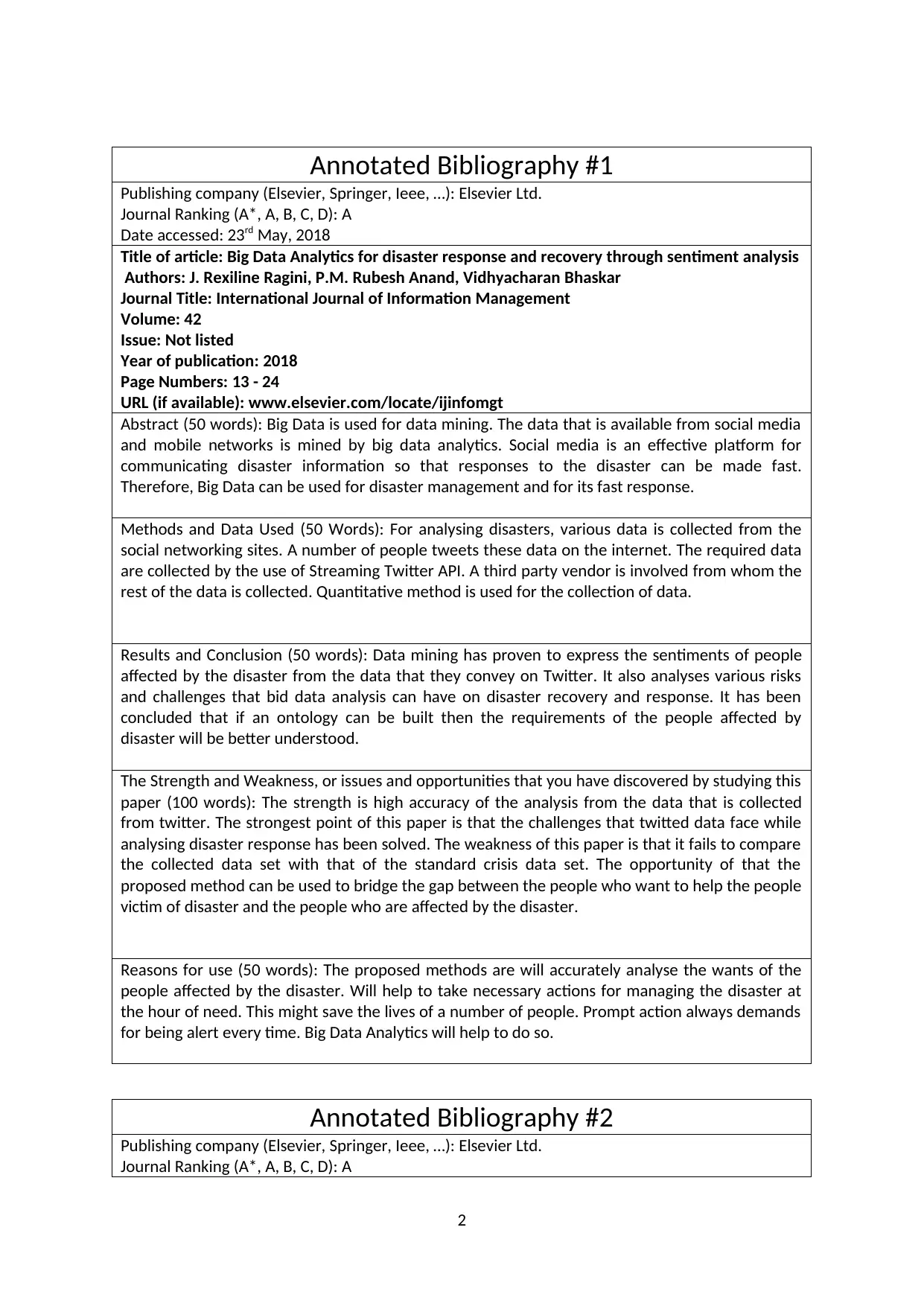
Annotated Bibliography #1
Publishing company (Elsevier, Springer, Ieee, …): Elsevier Ltd.
Journal Ranking (A*, A, B, C, D): A
Date accessed: 23rd May, 2018
Title of article: Big Data Analytics for disaster response and recovery through sentiment analysis
Authors: J. Rexiline Ragini, P.M. Rubesh Anand, Vidhyacharan Bhaskar
Journal Title: International Journal of Information Management
Volume: 42
Issue: Not listed
Year of publication: 2018
Page Numbers: 13 - 24
URL (if available): www.elsevier.com/locate/ijinfomgt
Abstract (50 words): Big Data is used for data mining. The data that is available from social media
and mobile networks is mined by big data analytics. Social media is an effective platform for
communicating disaster information so that responses to the disaster can be made fast.
Therefore, Big Data can be used for disaster management and for its fast response.
Methods and Data Used (50 Words): For analysing disasters, various data is collected from the
social networking sites. A number of people tweets these data on the internet. The required data
are collected by the use of Streaming Twitter API. A third party vendor is involved from whom the
rest of the data is collected. Quantitative method is used for the collection of data.
Results and Conclusion (50 words): Data mining has proven to express the sentiments of people
affected by the disaster from the data that they convey on Twitter. It also analyses various risks
and challenges that bid data analysis can have on disaster recovery and response. It has been
concluded that if an ontology can be built then the requirements of the people affected by
disaster will be better understood.
The Strength and Weakness, or issues and opportunities that you have discovered by studying this
paper (100 words): The strength is high accuracy of the analysis from the data that is collected
from twitter. The strongest point of this paper is that the challenges that twitted data face while
analysing disaster response has been solved. The weakness of this paper is that it fails to compare
the collected data set with that of the standard crisis data set. The opportunity of that the
proposed method can be used to bridge the gap between the people who want to help the people
victim of disaster and the people who are affected by the disaster.
Reasons for use (50 words): The proposed methods are will accurately analyse the wants of the
people affected by the disaster. Will help to take necessary actions for managing the disaster at
the hour of need. This might save the lives of a number of people. Prompt action always demands
for being alert every time. Big Data Analytics will help to do so.
Annotated Bibliography #2
Publishing company (Elsevier, Springer, Ieee, …): Elsevier Ltd.
Journal Ranking (A*, A, B, C, D): A
2
Publishing company (Elsevier, Springer, Ieee, …): Elsevier Ltd.
Journal Ranking (A*, A, B, C, D): A
Date accessed: 23rd May, 2018
Title of article: Big Data Analytics for disaster response and recovery through sentiment analysis
Authors: J. Rexiline Ragini, P.M. Rubesh Anand, Vidhyacharan Bhaskar
Journal Title: International Journal of Information Management
Volume: 42
Issue: Not listed
Year of publication: 2018
Page Numbers: 13 - 24
URL (if available): www.elsevier.com/locate/ijinfomgt
Abstract (50 words): Big Data is used for data mining. The data that is available from social media
and mobile networks is mined by big data analytics. Social media is an effective platform for
communicating disaster information so that responses to the disaster can be made fast.
Therefore, Big Data can be used for disaster management and for its fast response.
Methods and Data Used (50 Words): For analysing disasters, various data is collected from the
social networking sites. A number of people tweets these data on the internet. The required data
are collected by the use of Streaming Twitter API. A third party vendor is involved from whom the
rest of the data is collected. Quantitative method is used for the collection of data.
Results and Conclusion (50 words): Data mining has proven to express the sentiments of people
affected by the disaster from the data that they convey on Twitter. It also analyses various risks
and challenges that bid data analysis can have on disaster recovery and response. It has been
concluded that if an ontology can be built then the requirements of the people affected by
disaster will be better understood.
The Strength and Weakness, or issues and opportunities that you have discovered by studying this
paper (100 words): The strength is high accuracy of the analysis from the data that is collected
from twitter. The strongest point of this paper is that the challenges that twitted data face while
analysing disaster response has been solved. The weakness of this paper is that it fails to compare
the collected data set with that of the standard crisis data set. The opportunity of that the
proposed method can be used to bridge the gap between the people who want to help the people
victim of disaster and the people who are affected by the disaster.
Reasons for use (50 words): The proposed methods are will accurately analyse the wants of the
people affected by the disaster. Will help to take necessary actions for managing the disaster at
the hour of need. This might save the lives of a number of people. Prompt action always demands
for being alert every time. Big Data Analytics will help to do so.
Annotated Bibliography #2
Publishing company (Elsevier, Springer, Ieee, …): Elsevier Ltd.
Journal Ranking (A*, A, B, C, D): A
2
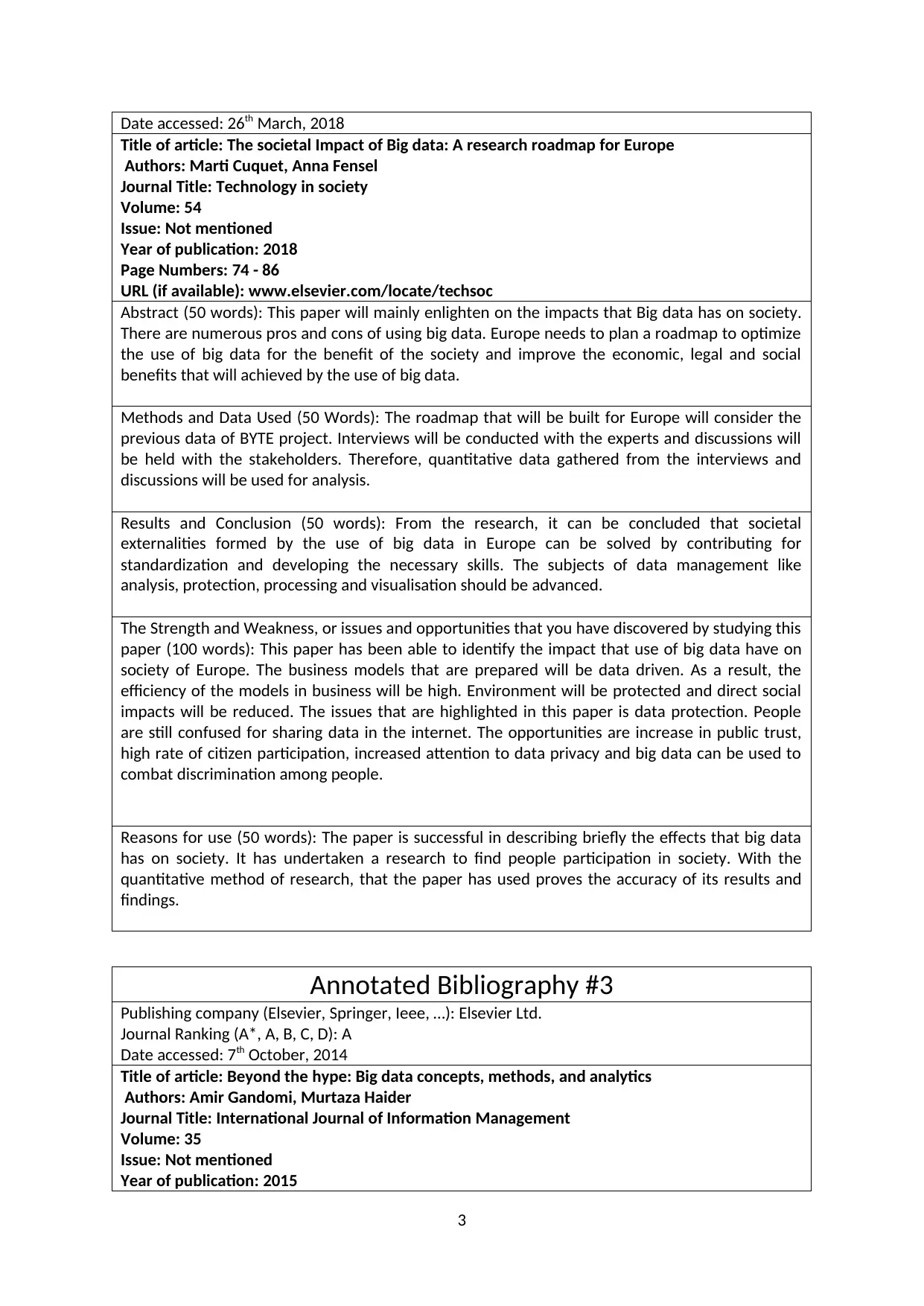
Date accessed: 26th March, 2018
Title of article: The societal Impact of Big data: A research roadmap for Europe
Authors: Marti Cuquet, Anna Fensel
Journal Title: Technology in society
Volume: 54
Issue: Not mentioned
Year of publication: 2018
Page Numbers: 74 - 86
URL (if available): www.elsevier.com/locate/techsoc
Abstract (50 words): This paper will mainly enlighten on the impacts that Big data has on society.
There are numerous pros and cons of using big data. Europe needs to plan a roadmap to optimize
the use of big data for the benefit of the society and improve the economic, legal and social
benefits that will achieved by the use of big data.
Methods and Data Used (50 Words): The roadmap that will be built for Europe will consider the
previous data of BYTE project. Interviews will be conducted with the experts and discussions will
be held with the stakeholders. Therefore, quantitative data gathered from the interviews and
discussions will be used for analysis.
Results and Conclusion (50 words): From the research, it can be concluded that societal
externalities formed by the use of big data in Europe can be solved by contributing for
standardization and developing the necessary skills. The subjects of data management like
analysis, protection, processing and visualisation should be advanced.
The Strength and Weakness, or issues and opportunities that you have discovered by studying this
paper (100 words): This paper has been able to identify the impact that use of big data have on
society of Europe. The business models that are prepared will be data driven. As a result, the
efficiency of the models in business will be high. Environment will be protected and direct social
impacts will be reduced. The issues that are highlighted in this paper is data protection. People
are still confused for sharing data in the internet. The opportunities are increase in public trust,
high rate of citizen participation, increased attention to data privacy and big data can be used to
combat discrimination among people.
Reasons for use (50 words): The paper is successful in describing briefly the effects that big data
has on society. It has undertaken a research to find people participation in society. With the
quantitative method of research, that the paper has used proves the accuracy of its results and
findings.
Annotated Bibliography #3
Publishing company (Elsevier, Springer, Ieee, …): Elsevier Ltd.
Journal Ranking (A*, A, B, C, D): A
Date accessed: 7th October, 2014
Title of article: Beyond the hype: Big data concepts, methods, and analytics
Authors: Amir Gandomi, Murtaza Haider
Journal Title: International Journal of Information Management
Volume: 35
Issue: Not mentioned
Year of publication: 2015
3
Title of article: The societal Impact of Big data: A research roadmap for Europe
Authors: Marti Cuquet, Anna Fensel
Journal Title: Technology in society
Volume: 54
Issue: Not mentioned
Year of publication: 2018
Page Numbers: 74 - 86
URL (if available): www.elsevier.com/locate/techsoc
Abstract (50 words): This paper will mainly enlighten on the impacts that Big data has on society.
There are numerous pros and cons of using big data. Europe needs to plan a roadmap to optimize
the use of big data for the benefit of the society and improve the economic, legal and social
benefits that will achieved by the use of big data.
Methods and Data Used (50 Words): The roadmap that will be built for Europe will consider the
previous data of BYTE project. Interviews will be conducted with the experts and discussions will
be held with the stakeholders. Therefore, quantitative data gathered from the interviews and
discussions will be used for analysis.
Results and Conclusion (50 words): From the research, it can be concluded that societal
externalities formed by the use of big data in Europe can be solved by contributing for
standardization and developing the necessary skills. The subjects of data management like
analysis, protection, processing and visualisation should be advanced.
The Strength and Weakness, or issues and opportunities that you have discovered by studying this
paper (100 words): This paper has been able to identify the impact that use of big data have on
society of Europe. The business models that are prepared will be data driven. As a result, the
efficiency of the models in business will be high. Environment will be protected and direct social
impacts will be reduced. The issues that are highlighted in this paper is data protection. People
are still confused for sharing data in the internet. The opportunities are increase in public trust,
high rate of citizen participation, increased attention to data privacy and big data can be used to
combat discrimination among people.
Reasons for use (50 words): The paper is successful in describing briefly the effects that big data
has on society. It has undertaken a research to find people participation in society. With the
quantitative method of research, that the paper has used proves the accuracy of its results and
findings.
Annotated Bibliography #3
Publishing company (Elsevier, Springer, Ieee, …): Elsevier Ltd.
Journal Ranking (A*, A, B, C, D): A
Date accessed: 7th October, 2014
Title of article: Beyond the hype: Big data concepts, methods, and analytics
Authors: Amir Gandomi, Murtaza Haider
Journal Title: International Journal of Information Management
Volume: 35
Issue: Not mentioned
Year of publication: 2015
3
⊘ This is a preview!⊘
Do you want full access?
Subscribe today to unlock all pages.

Trusted by 1+ million students worldwide
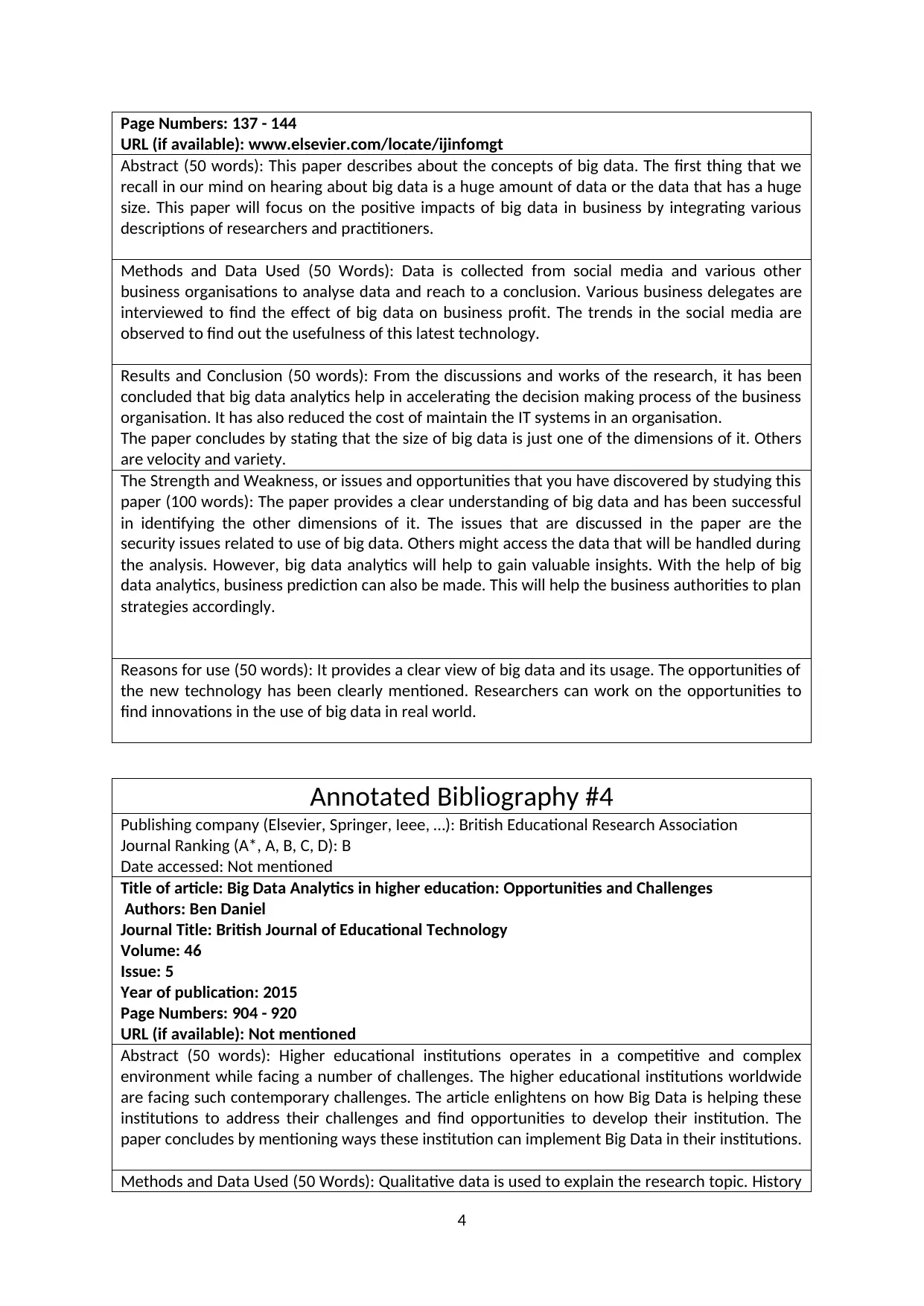
Page Numbers: 137 - 144
URL (if available): www.elsevier.com/locate/ijinfomgt
Abstract (50 words): This paper describes about the concepts of big data. The first thing that we
recall in our mind on hearing about big data is a huge amount of data or the data that has a huge
size. This paper will focus on the positive impacts of big data in business by integrating various
descriptions of researchers and practitioners.
Methods and Data Used (50 Words): Data is collected from social media and various other
business organisations to analyse data and reach to a conclusion. Various business delegates are
interviewed to find the effect of big data on business profit. The trends in the social media are
observed to find out the usefulness of this latest technology.
Results and Conclusion (50 words): From the discussions and works of the research, it has been
concluded that big data analytics help in accelerating the decision making process of the business
organisation. It has also reduced the cost of maintain the IT systems in an organisation.
The paper concludes by stating that the size of big data is just one of the dimensions of it. Others
are velocity and variety.
The Strength and Weakness, or issues and opportunities that you have discovered by studying this
paper (100 words): The paper provides a clear understanding of big data and has been successful
in identifying the other dimensions of it. The issues that are discussed in the paper are the
security issues related to use of big data. Others might access the data that will be handled during
the analysis. However, big data analytics will help to gain valuable insights. With the help of big
data analytics, business prediction can also be made. This will help the business authorities to plan
strategies accordingly.
Reasons for use (50 words): It provides a clear view of big data and its usage. The opportunities of
the new technology has been clearly mentioned. Researchers can work on the opportunities to
find innovations in the use of big data in real world.
Annotated Bibliography #4
Publishing company (Elsevier, Springer, Ieee, …): British Educational Research Association
Journal Ranking (A*, A, B, C, D): B
Date accessed: Not mentioned
Title of article: Big Data Analytics in higher education: Opportunities and Challenges
Authors: Ben Daniel
Journal Title: British Journal of Educational Technology
Volume: 46
Issue: 5
Year of publication: 2015
Page Numbers: 904 - 920
URL (if available): Not mentioned
Abstract (50 words): Higher educational institutions operates in a competitive and complex
environment while facing a number of challenges. The higher educational institutions worldwide
are facing such contemporary challenges. The article enlightens on how Big Data is helping these
institutions to address their challenges and find opportunities to develop their institution. The
paper concludes by mentioning ways these institution can implement Big Data in their institutions.
Methods and Data Used (50 Words): Qualitative data is used to explain the research topic. History
4
URL (if available): www.elsevier.com/locate/ijinfomgt
Abstract (50 words): This paper describes about the concepts of big data. The first thing that we
recall in our mind on hearing about big data is a huge amount of data or the data that has a huge
size. This paper will focus on the positive impacts of big data in business by integrating various
descriptions of researchers and practitioners.
Methods and Data Used (50 Words): Data is collected from social media and various other
business organisations to analyse data and reach to a conclusion. Various business delegates are
interviewed to find the effect of big data on business profit. The trends in the social media are
observed to find out the usefulness of this latest technology.
Results and Conclusion (50 words): From the discussions and works of the research, it has been
concluded that big data analytics help in accelerating the decision making process of the business
organisation. It has also reduced the cost of maintain the IT systems in an organisation.
The paper concludes by stating that the size of big data is just one of the dimensions of it. Others
are velocity and variety.
The Strength and Weakness, or issues and opportunities that you have discovered by studying this
paper (100 words): The paper provides a clear understanding of big data and has been successful
in identifying the other dimensions of it. The issues that are discussed in the paper are the
security issues related to use of big data. Others might access the data that will be handled during
the analysis. However, big data analytics will help to gain valuable insights. With the help of big
data analytics, business prediction can also be made. This will help the business authorities to plan
strategies accordingly.
Reasons for use (50 words): It provides a clear view of big data and its usage. The opportunities of
the new technology has been clearly mentioned. Researchers can work on the opportunities to
find innovations in the use of big data in real world.
Annotated Bibliography #4
Publishing company (Elsevier, Springer, Ieee, …): British Educational Research Association
Journal Ranking (A*, A, B, C, D): B
Date accessed: Not mentioned
Title of article: Big Data Analytics in higher education: Opportunities and Challenges
Authors: Ben Daniel
Journal Title: British Journal of Educational Technology
Volume: 46
Issue: 5
Year of publication: 2015
Page Numbers: 904 - 920
URL (if available): Not mentioned
Abstract (50 words): Higher educational institutions operates in a competitive and complex
environment while facing a number of challenges. The higher educational institutions worldwide
are facing such contemporary challenges. The article enlightens on how Big Data is helping these
institutions to address their challenges and find opportunities to develop their institution. The
paper concludes by mentioning ways these institution can implement Big Data in their institutions.
Methods and Data Used (50 Words): Qualitative data is used to explain the research topic. History
4
Paraphrase This Document
Need a fresh take? Get an instant paraphrase of this document with our AI Paraphraser
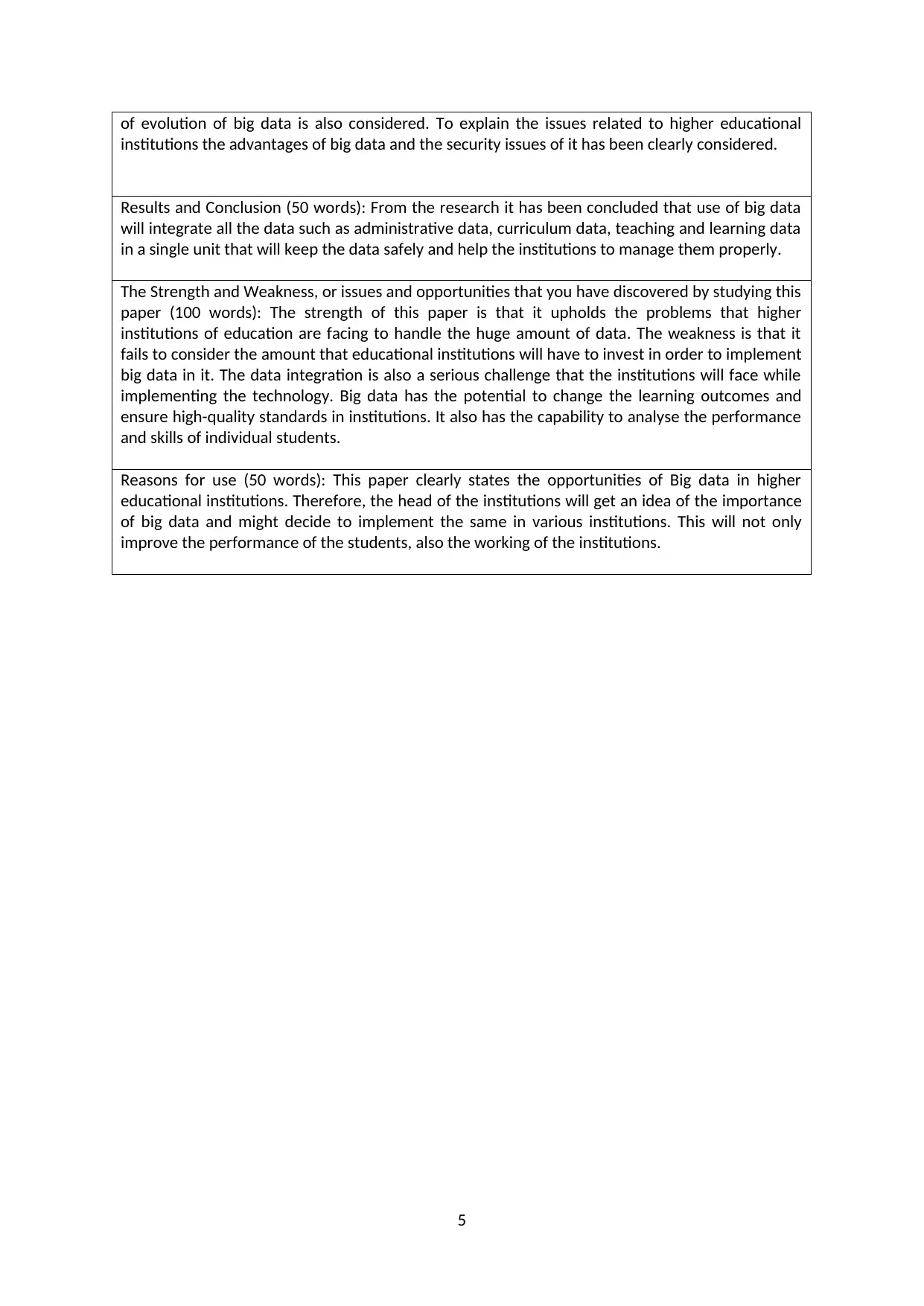
of evolution of big data is also considered. To explain the issues related to higher educational
institutions the advantages of big data and the security issues of it has been clearly considered.
Results and Conclusion (50 words): From the research it has been concluded that use of big data
will integrate all the data such as administrative data, curriculum data, teaching and learning data
in a single unit that will keep the data safely and help the institutions to manage them properly.
The Strength and Weakness, or issues and opportunities that you have discovered by studying this
paper (100 words): The strength of this paper is that it upholds the problems that higher
institutions of education are facing to handle the huge amount of data. The weakness is that it
fails to consider the amount that educational institutions will have to invest in order to implement
big data in it. The data integration is also a serious challenge that the institutions will face while
implementing the technology. Big data has the potential to change the learning outcomes and
ensure high-quality standards in institutions. It also has the capability to analyse the performance
and skills of individual students.
Reasons for use (50 words): This paper clearly states the opportunities of Big data in higher
educational institutions. Therefore, the head of the institutions will get an idea of the importance
of big data and might decide to implement the same in various institutions. This will not only
improve the performance of the students, also the working of the institutions.
5
institutions the advantages of big data and the security issues of it has been clearly considered.
Results and Conclusion (50 words): From the research it has been concluded that use of big data
will integrate all the data such as administrative data, curriculum data, teaching and learning data
in a single unit that will keep the data safely and help the institutions to manage them properly.
The Strength and Weakness, or issues and opportunities that you have discovered by studying this
paper (100 words): The strength of this paper is that it upholds the problems that higher
institutions of education are facing to handle the huge amount of data. The weakness is that it
fails to consider the amount that educational institutions will have to invest in order to implement
big data in it. The data integration is also a serious challenge that the institutions will face while
implementing the technology. Big data has the potential to change the learning outcomes and
ensure high-quality standards in institutions. It also has the capability to analyse the performance
and skills of individual students.
Reasons for use (50 words): This paper clearly states the opportunities of Big data in higher
educational institutions. Therefore, the head of the institutions will get an idea of the importance
of big data and might decide to implement the same in various institutions. This will not only
improve the performance of the students, also the working of the institutions.
5
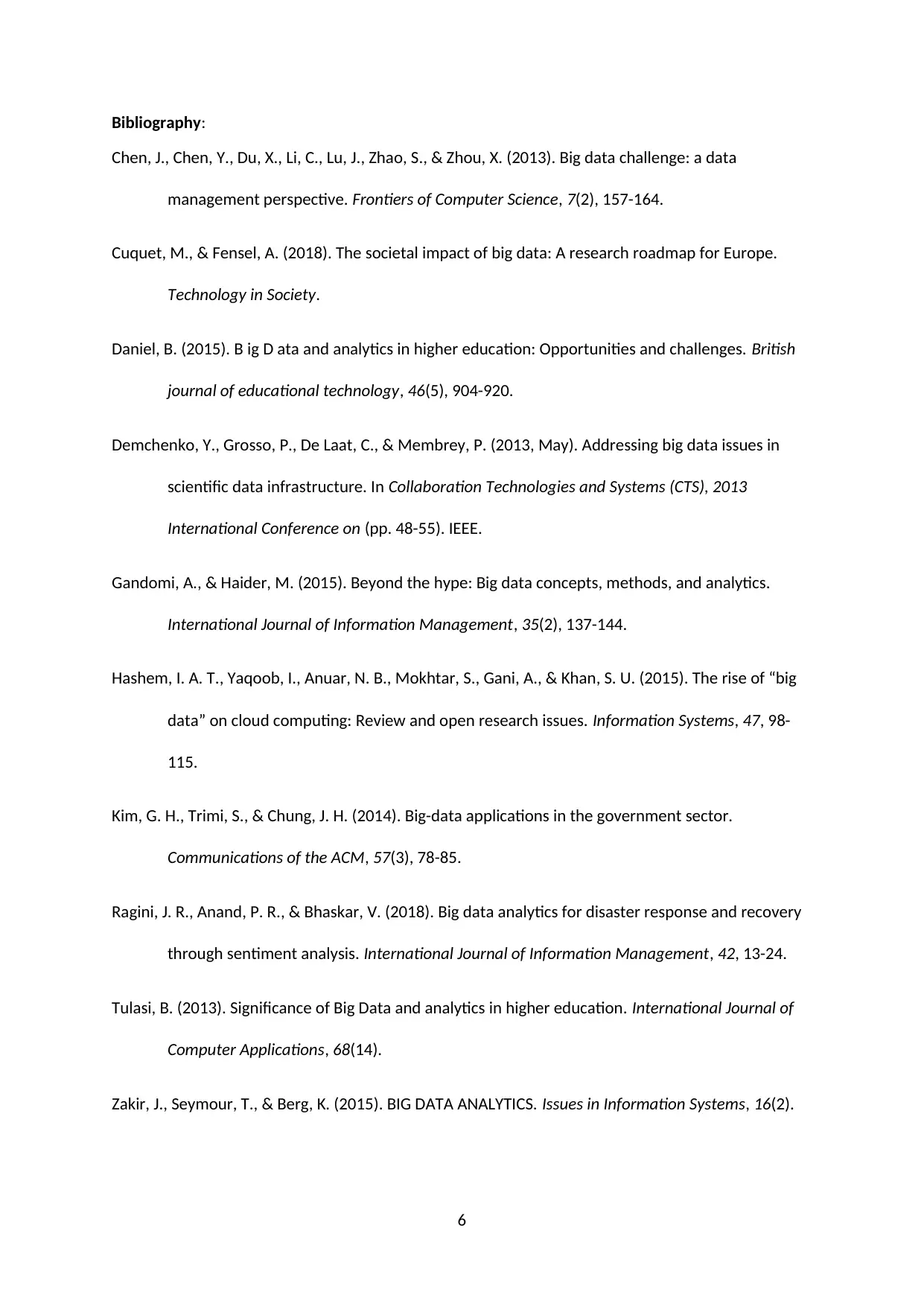
Bibliography:
Chen, J., Chen, Y., Du, X., Li, C., Lu, J., Zhao, S., & Zhou, X. (2013). Big data challenge: a data
management perspective. Frontiers of Computer Science, 7(2), 157-164.
Cuquet, M., & Fensel, A. (2018). The societal impact of big data: A research roadmap for Europe.
Technology in Society.
Daniel, B. (2015). B ig D ata and analytics in higher education: Opportunities and challenges. British
journal of educational technology, 46(5), 904-920.
Demchenko, Y., Grosso, P., De Laat, C., & Membrey, P. (2013, May). Addressing big data issues in
scientific data infrastructure. In Collaboration Technologies and Systems (CTS), 2013
International Conference on (pp. 48-55). IEEE.
Gandomi, A., & Haider, M. (2015). Beyond the hype: Big data concepts, methods, and analytics.
International Journal of Information Management, 35(2), 137-144.
Hashem, I. A. T., Yaqoob, I., Anuar, N. B., Mokhtar, S., Gani, A., & Khan, S. U. (2015). The rise of “big
data” on cloud computing: Review and open research issues. Information Systems, 47, 98-
115.
Kim, G. H., Trimi, S., & Chung, J. H. (2014). Big-data applications in the government sector.
Communications of the ACM, 57(3), 78-85.
Ragini, J. R., Anand, P. R., & Bhaskar, V. (2018). Big data analytics for disaster response and recovery
through sentiment analysis. International Journal of Information Management, 42, 13-24.
Tulasi, B. (2013). Significance of Big Data and analytics in higher education. International Journal of
Computer Applications, 68(14).
Zakir, J., Seymour, T., & Berg, K. (2015). BIG DATA ANALYTICS. Issues in Information Systems, 16(2).
6
Chen, J., Chen, Y., Du, X., Li, C., Lu, J., Zhao, S., & Zhou, X. (2013). Big data challenge: a data
management perspective. Frontiers of Computer Science, 7(2), 157-164.
Cuquet, M., & Fensel, A. (2018). The societal impact of big data: A research roadmap for Europe.
Technology in Society.
Daniel, B. (2015). B ig D ata and analytics in higher education: Opportunities and challenges. British
journal of educational technology, 46(5), 904-920.
Demchenko, Y., Grosso, P., De Laat, C., & Membrey, P. (2013, May). Addressing big data issues in
scientific data infrastructure. In Collaboration Technologies and Systems (CTS), 2013
International Conference on (pp. 48-55). IEEE.
Gandomi, A., & Haider, M. (2015). Beyond the hype: Big data concepts, methods, and analytics.
International Journal of Information Management, 35(2), 137-144.
Hashem, I. A. T., Yaqoob, I., Anuar, N. B., Mokhtar, S., Gani, A., & Khan, S. U. (2015). The rise of “big
data” on cloud computing: Review and open research issues. Information Systems, 47, 98-
115.
Kim, G. H., Trimi, S., & Chung, J. H. (2014). Big-data applications in the government sector.
Communications of the ACM, 57(3), 78-85.
Ragini, J. R., Anand, P. R., & Bhaskar, V. (2018). Big data analytics for disaster response and recovery
through sentiment analysis. International Journal of Information Management, 42, 13-24.
Tulasi, B. (2013). Significance of Big Data and analytics in higher education. International Journal of
Computer Applications, 68(14).
Zakir, J., Seymour, T., & Berg, K. (2015). BIG DATA ANALYTICS. Issues in Information Systems, 16(2).
6
⊘ This is a preview!⊘
Do you want full access?
Subscribe today to unlock all pages.

Trusted by 1+ million students worldwide
1 out of 6
Your All-in-One AI-Powered Toolkit for Academic Success.
+13062052269
info@desklib.com
Available 24*7 on WhatsApp / Email
![[object Object]](/_next/static/media/star-bottom.7253800d.svg)
Unlock your academic potential
Copyright © 2020–2025 A2Z Services. All Rights Reserved. Developed and managed by ZUCOL.

